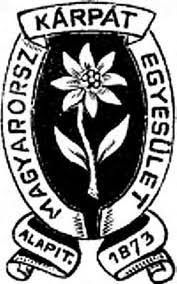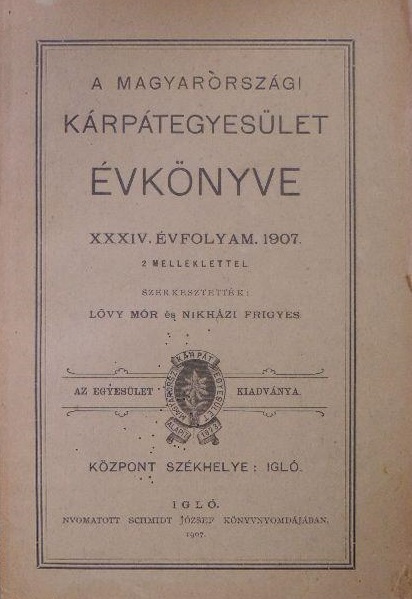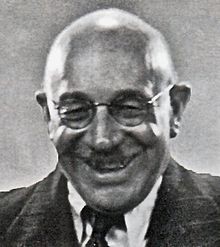According to some researchers, the European home of tourism is the Bańska Szczawnica region (Szczawnickie Wierchy, to be exact, with mt. Sitno as the highest mountain (Szitne in Hungarian – 1009 m. high.). it is there that in 1860 Sittnia Club was formed, which functioned till 1874. Until now people argue whether the organisation was more Slovak or Hungarian[1]. The society’s initiator was a Hungarian named Ede Schostál, after whom the neighbouring places were named (a nearby meadow and water spring, named after Schostál).

Emblem of the Hungarian, Carpathian Association.
The oldest of the Tatra mountain societies, was the Hungarian Carpathian Association, formed in 1873 (Magyarországi Kárpát Egyesület - MKE). Officially the organisation was German-Hungarian, since, alongside the Hungarians, inhabiting the Tatra mountains, it was formed by the Zips town Germans. In 1869, the initiator of the organisation was an Austrian doctor dr Heinrich Wellmann. Two years later he wrote an address in German, Hungarian and Polish, where he called for the formation of a new association. In spite of distributing a thousand papers, he was only answered by six people: dr Mór Déchy[2] - an attorney from Budapest, dr Jozsef Fülöp – an attorney from Bratislava, Wilhelm Hauszmann from Konigsberg, Józef Stefan Szalay[3] - the owner of the town of Szczawnica, of Hungarian origin, and Julius Zimmerman – a professor from the town of Kežmarok. It was that last man, who made the next attempt to create an organisation, which ultimately failed. The next person involved in the development of the idea, was Anton Döller, a retired Austrian Major, and a great lover of alpinism. In 1872, he came to live in the town of Kežmarok. He decided to continue Zimmermann’s work, convincing people from higher social classes, to take part in his scheme. All the people interested, met on Sunday the 11th of May 1873, for the first time. A week later the society’s statute was formed, and on the 10th of August 1873 the founding meeting took place in the town of Stary Smokovec. The meeting was attended by 70 members, including one Pole, Stefan Buszczyński[4]. The town of Kežmarok was chosen for the headquarters of the association. And a year later the Tatra Association, was formed on the other side of the Tatra mountains.

A cover of the Hungarian Carpathian Association’s annal from 1907
In 1874, the Hungarian Carpathian Association, published the first volume of its annals. They were published in two languages, in Hungarian (Magyarországi Kárpátegyesület Évkönyve) and German (Jahrbuch des Ungarischen Karpathenvereins). The annals were published regularly until 1917[5], and contained articles, devoted to mountain tourism, and reports from expeditions. Occasionally they also included work written by Polish authors.
During the years 1884 – 1891 the headquarters of the Association’s main board, was the town of Levoca, and between 1891 and 1920 Nowa Wieś Spiska. In 1891, some members left the MKE, forming the Hungarian, Tourist Association (Magyar Turista Egyesület, MTE), located in Budapest, which wasn’t limited to mountain tourism only.
The Hungarian Carpathian Society, carried out broad journalistic and didactic activity. The main efforts concentrating mostly on popularising tourism in the Tatra mountains, by building mountain shelters The most popular ones being the Shelter by the Strbske Lake (built in 1875), the Shelter in the Kežmarok Valley (1876), moved in 1880, to the shore of the Kežmarok Green Pond, the Shelter by Wielicki Staw (1878), The Shelter by Popradske Pleso (1879). The MKE, also marked many routs and paths: The Turystowska road, leading from the Bielskie Caves, to the Strbske lake, the road from Niżni Szmeks, to the Turystowska road, the path in the Kežmarok Valley, the path from Szmeks, through Siodełko, to the Pod Kozicą Hotel. The mountain path from Dolina Wielicka, to Polski Grzebień and Mała Wysoka and to Staw Batyżowiecki, the path to mt. Rysy and Ilinczowe Stawy, and a number of markings on other routes.
Apart from its mountain activities, the Association, organised the traffic in the Tatra mountains in all its aspects. Tour guides were educated, and equipped with ropes and other the necessary tools. The Voluntary Rescue Department was formed, which carried out rescue missions, when it was necessary. In addition, the shelters on the other side of the Tatra mountains, were equipped with telephone lines and sanitary equipment. Finally, in 1887 in the town of Poprad, the Carpathian Museum was officially opened, with 12 thousand exhibits. In 1922, their number rose to 40 thousand items.

Reklama sprzętu turystycznego zamieszczona w roczniku Węgierskiego Towarzystwa Karpackiego
Wzorcowo układała się współpraca Towarzystwa z rządem węgierskim, który nie szczędził środków na budowę ścieżek, dróg oraz urządzeń turystycznych w miasteczkach uzdrowiskowych. Wsparcie oferowali również zarządcy uzdrowisk oraz miast spiskich. Jakże odmienna była sytuacja po drugiej stronie Tatr. Polskie Towarzystwo Tatrzańskie musiało własnymi siłami oświetlać ulice, budować linie telegraficzne oraz utrzymywać parki uzdrowiskowe. Ubolewano, że „władze zakopiańskie nie widzą nic poza chodnikiem na Krupówkach, wielką lampą przed mieszkaniem byłego wójta oraz ściąganiem taksy klimatycznej, a Towarzystwo Tatrzańskie „w dowód uznania” otrzymuje od rządu zasiłki, umożliwiające mu zakup nowego wiaderka, lichtarza i papierowego siennika.”

Shelter by Popradske Pleso in 1888.
The cooperation between the Society and the Hungarian government was exemplary, which was generous in granting the finances needed for the building of roads, paths and tourist facilities in spa towns. The spa and Zips town governors also offered their support. The situation on the other side of the Tatra mountains could not be any more different. The Polish Tatra Society, had to use their own means to light the streets, build telegraph lines and support spa town parks. The complaints were that: “The Zakopane town authorities, see nothing apart from the pavement on the street of Krupuwki, the big lamp in front of the ex-mayor’s house, and the collection of the climate tax. The Tatra Society, in turn, receives subsidies from the government “as a token of appreciation”, enabling them to buy a new bucket, a candlestick, and a paper pallet.”

Gyula Hefty
Throughout the time of its existence, not only did the organisation cooperate with the Polish friends, from the other side of the Tatra mountains, but also its members had great amity and respect for the Poles. An example to this, was the celebration of the society’s 50th anniversary, where the members of the Polish Tatra Association, were invited. The jubilee, was commenced by the chairman of the Carpathian Society, with the following words: “First of all, I’d like to welcome the deputies from the Polish Tatra Association, from Cracow, our Polish, brotherly society – barely younger, by just a few months – which has been working alongside us, for the past fifty years. We’ve been supporting, and learning from each other with hefty friendship inseparably binding us together.”
The representative of the Polish side, expressed great gratitude for the Society, which had greatly contributed to the development of Polish tourism, on the other side of the Tatras. He also acknowledged the difference between Polish and Hungarian meetings: “One thing that ought to be stressed is the moderation of the speakers, thanks to which, the proceedings, could finish before two and a half hours, in spite of the long agenda. A time record unreachable for us, who on such occasions, suffer from an incurable solitaire of oratory performances. The atmosphere in the room, was serious and focused.”
All throughout the event, the first part of the association’s name, operating for the first 46 years of its existence, was not mentioned, in fear of government repressions.
After the disintegration of Czechoslovakia in march 1939, the organisation, was seized by the Nazis. The ordinary members, however, remained faithful to their ideals, and altruistically continued to help the mountaineering tourists. After the end of World War II, the Czechoslovakian authorities dissolved the Carpathian Society.
Bibliography:
Dzieje Polskiego Towarzystwa Tatrzańskiego; Warszawa-Kraków 1988.
Roczniki Węgierskiego Towarzystwa Karpackiego (Magyarországi Kárpátegyesület Évkönyve); 1874-1917.
Taternik. Organ Sekcji Turystycznej Polskiego Towarzystwa Tatrzańskiego; Lwów, Kraków, Zakopane (wydawany w latach 1907-1912, 1912-1924, 1928-1942).
Wiek Nowy. Popularny dziennik ilustrowany; Lwów 1901-1939.
[1]According to the present Hungarian encyclopedia of tourism, Sittnya Club, was the first tourist organisation in Hungary.
[2r Déchy – born Nov. 4th 1847 in Buda. Hungarian traveller and geographer, one of the first high mountain photographer. Tatra and Alpine mountaineer. Died Feb. 8th 1917 in Budapest.
[3] Józef Szalay – born in 1802 in Drohobycz. A Pole of Hungarian descent. The creator of a Spa in the town of Szczawnica, where he died, on May 11th 1976.
[4] Stefan Buszczyński – born on Dec 26th 1821 in the Podole region. A journalist and political writer. Took part in the January Uprising, for which he was given an in absentia death penalty. Died on Nov. 20th 1892, in Cracow.
[5] All the annals in pdf format, are accessable on the following website: http://real-j.mtak.hu/view/journal/A_Magyarorsz=E1gi_K=E1rp=E1tegylet_=E9vk=F6nyve.html.

Michał Kawęcki, urodzony w 1987 roku. Politolog, założyciel i prezes Stowarzyszenia Sympatyków I. Lwowskiego Klubu Sportowego Czarni Lwów. Autor monografii najstarszego polskiego klubu piłkarskiego.
